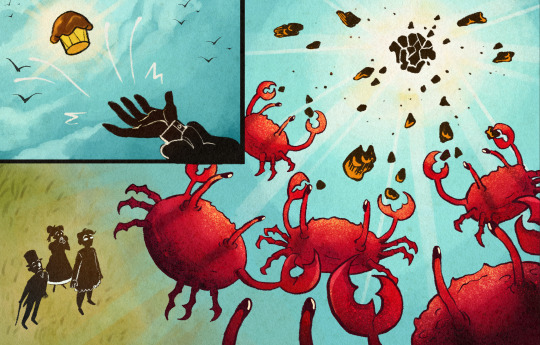#visiting naturalist
Text
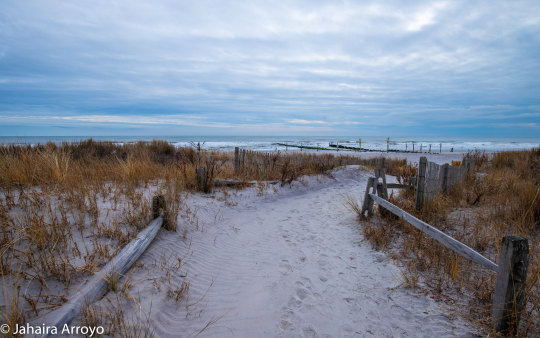
Atlantic City, New Jersey
I was lucky with the lightning that afternoon.
#photographers on tumblr#east coast#new jersey#jersey shore#visit new jersey#travel photography#landscape photography#nature hikes#beach vibes#beach photography#summer#beachlife#atlantic city#travel photographer#landscape#nature photography#naturalist#nature photographer#nature#landscapes#north east coast#coastal
10 notes
·
View notes
Text

#travel#photography#nature#naturalist#geology#leaves#leafsforever#natural photography#places to visit#visit nature
1 note
·
View note
Note
Hi guys! I love your podcast as much as I love this site. I was wondering if you guys have thought about talking to the @visiting-naturalist. Maybe you can even reach them and have a quick chat if their work at the society is not taking that much time. I, for one, really miss them and would love to know if they plan in returning with their research into these wild lands. Chao!
hello!!! thank you so much!!! we love this site so much too :)
I (Lauren) am not familiar with the visiting naturalist but I am absolutely going to get into it now!!! thank you for the intel!!
1 note
·
View note
Text
i'm too...skeptical of a person to vibe with much of the "witchcraft" adjacent spirituality that's popular nowadays
However, one of the most difficult things to understand about The Past is that for many of your ancestors, the distinction between "spiritual" and "mundane" phenomena did not exist.
and this does create problems for the idea that "science is for one set of questions, religion is for another" or at least the idea that "witchcraft" is a religion (exclusively). In The Past, philosophers speculated about the universe from the point of view that there were spiritual realities and that they weren't distinct from material realities. Before the modern idea of gravity, there was the idea that the four classical elements each had a particular nature, with earth being the heaviest and fire being the lightest. This also corresponded to a moral reality about the elements—the lighter elements were more "pure." (This is why in Dante's Inferno at the center of the Earth is Satan himself.) These people weren't assigning morals to substances in the way we now think of it. Their spiritual and moral realities were just "real" in the same way as the physical world.
People asked "From what we know of God, what can we hypothesize about the existence of extraterrestrial planets and beings, and what they are like?" And it's interesting to note that the belief in God didn't obstruct them from asking these questions; instead, it allowed them to ask these questions at a time when they didn't have naturalistic observations to go on.
But I'm getting off track—modern science is derived from things like alchemy and philosophy, and we are a bit biased here because we tend to see Aristotle and the like as precursors to "science," whereas when indigenous people maintain and pass down a collective body of naturalistic observations about their world, that's seen as some kind of cutesy pagan thing. Which is just racism.
In reality, ancient astronomers were also priests, medicine was practiced by shamans. They were people with knowledge that the average person did not possess. If there's a generic word for this type of person, it's "wise woman" or "wise man": the "three wise men" that are said to have visited Jesus were astronomers. The figures we see as "spiritual" often dealt primarily, and sometimes almost exclusively, with physical, natural phenomena. When they did deal with spiritual phenomena, it was for a lot of the same reasons that we do.
(Arguably, we have a worse understanding of some things, because we see everything in the physical world, including our own bodies, as unaffected by the meaning we assign them.)
What this means is that "witchcraft" can and should be to some extent "mundane" and evidence-based. But in my mind, "witchcraft" means possessing some kind of knowledge that is hands-on, practical, and not easily obtainable just by reading books or wikipedia, tempered by wisdom as a guide for when and how to apply it. It's also a social role; it suggests your knowledge makes you important to your community.
...
So I think an auto mechanic is technically some kind of witch.
6K notes
·
View notes
Text
Not to claim Godzilla x Kong was a deep film, but credit where it’s due, it has by far the most respectful portrayal of indigenous people in all of the Kong films.
This is not a high bar and I’m NOT saying it’s the pinnacle of progressive film work, but it’s interesting nonetheless.
Spoilers below, of course.
For those of you who haven’t seen any of the older Kong films outside of the Monsterverse, the general plot beat is that a wealthy businessman/philanthropist/greedy asshole goes to Skull Island to find something new to make a lot of money (film for the OG/Peter Jackson and Oil for the 70’s film), and comes across a tribe of “barbarian” natives who kidnap the beautiful white woman whom they sacrifice to Kong, whom they worship.
It’s such a cliche that even Peter Jackson does it in his 2005 film (and it’s possibly even more racist than the older ones):
youtube
youtube
youtube
As you can see, there is a very familiar pattern
The Iwi tribe of the Monsterverse is handled very differently
In Kong: Skull Island, it actually does try to play into previous viewers perceptions; we meet the Iwi as the protags stumble upon their village ruins and are surrounded by. Tension is tight, and it looks like it’ll be a repeat of the previous films… until the character of Hank Marlow arrives and diffuses the tension entirely, revealing that the Iwi have been generous and caring hosts to him.
And yes, while they do worship Kong, it’s not out of fear, but rather that Kong protects them from the hazards of Skull Island. The Iwi are the ones who help the crew get a working ship and aid them in escaping the island.
This is followed up in Godzilla vs Kong, where we tragically learn that a massive tropical storm (I think implied to be due to King Ghidorah hurricanes) sank the entire island and left Jia as the sole survivor of her tribe, saved due to Kong protecting her from the rising floods.
Kong and Jia are then seen as a near inseparable duo, further twisting the “beauty and beast” dynamic of the previous films, making it more about how they are both alone except for each other. Kong even learns sign language from Jia in one of the best movie reveals of the series:
youtube
It’s even Jia who is able to give Kong the morale boost to save Godzilla from Mechagodzilla.
And then we get into Godzilla x Kong. Kong and Jia, while having a new home, still feel isolated because of their cultures (or lack thereof) and make excuses to see each other as much as possible. Which is turned on its head as Kong finds other Apes and the Iwi tribe have returned (or at least) an offshoot of them, as the protectors of humanity who calls Godzilla to their aid.
I was a bit wary of making them telepathic, but I liked that they used it more like a separate language than a superpower, with Jia serving as that bridge as she finds her culture, her adoptive mother accepts that Jia may want this life more than one back home (where she felt out of place), and Jia becoming ANOTHER bridge as she helps resurrect Mothra who goes onto make Godzilla and Kong form an alliance!
Ultimately, Jia parts ways with the Iwi on good terms to live with her adoptive mother, happy to know there are people of her culture she can visit and Kong lives on with his people.
But I especially appreciate a moment in the film that pretty much lampshades the older Kong movies.
One of the characters is filming himself and others as they venture into Hollow Earth, desperate to get his fame and fortune in making people realize he was a hero and not a conspiracy theorist (he was a spy for Apex Labs, the ones who built mechagodzilla in the first place). Another character is an animal doctor and naturalist, who points out that, historically, native populations don’t tend to do well when exposed to the modern world.
Add on to the fact that the Iwi are telepathic and know how to use crystals to alter gravity in Hollow Earth, they would absolutely be the target of government operations and experimentation. Aka, a far more grand version of what happens in the older Kong films.
The film ends with the footage not being used and the Iwi living in peace, having Mothra once more to protect them.
Like I said, it’s not groundbreaking stuff, but I appreciate how different it is.
#godzilla#kong#king kong#monsterverse#godzilla vs kong#godzilla x kong: the new empire#kong skull island#kong: skull island#Iwi tribe#Jia#Youtube
107 notes
·
View notes
Note
I'm going to southern france next month. Any suggestions for common birds to keep an eye out for? Our library system had one book on birds of Europe and it's huge and overwhelming.
Birds of the Camargue
I do not have a way of knowing what birds are common in that region, versus what is occasional, but I can put you in touch with some resources, along with a few of the cooler birds from that region.
(*we messaged earlier about what are of southern France they would be visiting.)
Some good links:
Birds of Camargue - The Birds of Camargue (oiseaux-de-camargue.fr)
Accueil - Bureau des Guides Naturalistes - Site officiel (guide-nature.fr)
Birdwatching in the Camargue (surfbirds.com)
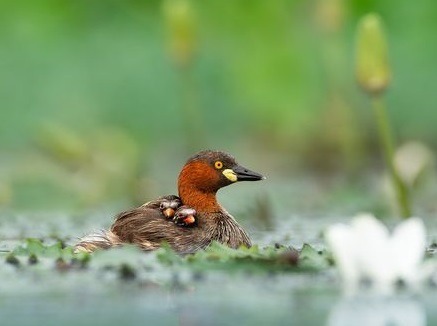
Little Grebes aka Dabchicks (Tachybaptus ruficollis), family Podicipedidae, order Podicipediformes
Photograph by Mainak Halder

Bearded Reedling aka Bearded Tit (Panurus biarmicus), family Panuridae, order Passeriformes
photograph by Carlo Galliani
https://www.facebook.com/carlo.galliani.58
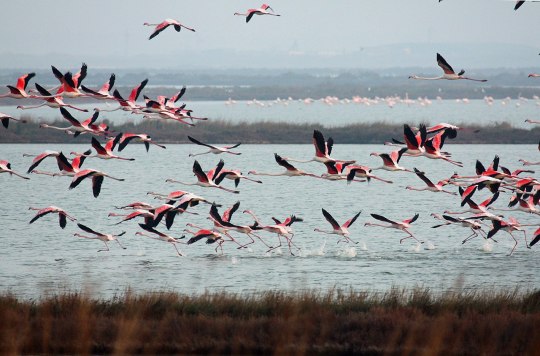
Greater Flamingo (Phoenicopterus roseus), family Phoenicopteridae, order Phoenicopteriformes
photograph by Carlo Pelagalli
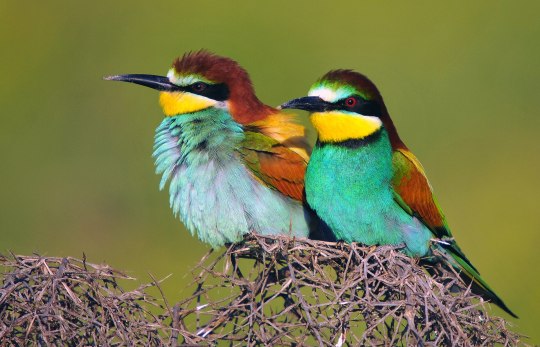
European Bee-eater (Merops apiaster), family Meropidae, order Coraciiformes
photograph by Dûrzan Cîrano

Eurasian Hoopoe (Upupa epops), family Upupidae, order Bucerotiformes
photograph by João Gomes
121 notes
·
View notes
Text
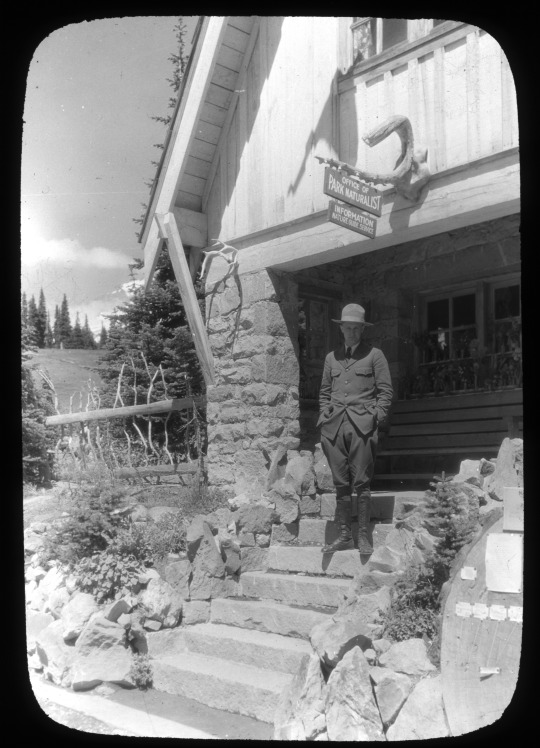
Mount Rainier National Park Archives Photo of the Paradise Ranger Station with the park’s first naturalist, Ranger Floyd Schmoe, in the 1920s.
The Paradise Ranger Station was constructed in 1921 and was the first government-built structure of its kind at Mount Rainier. Built by the National Park Service in the Rustic style, its steeply pitched roof was designed to withstand the excessive amounts of snowfall at Paradise. The front has a full width 1-story stone porch accessed by stone steps, which descend directly onto the sidewalk. The NPS Rustic style uses native materials like wood and stone to minimize contrast from the natural setting. Shrubs and trees were also planted around the ranger station to better help it blend with the environment and not detract from the visitors’ experience of nature. The Paradise Ranger Station is part of the Mount Rainier Historic Landmark District.
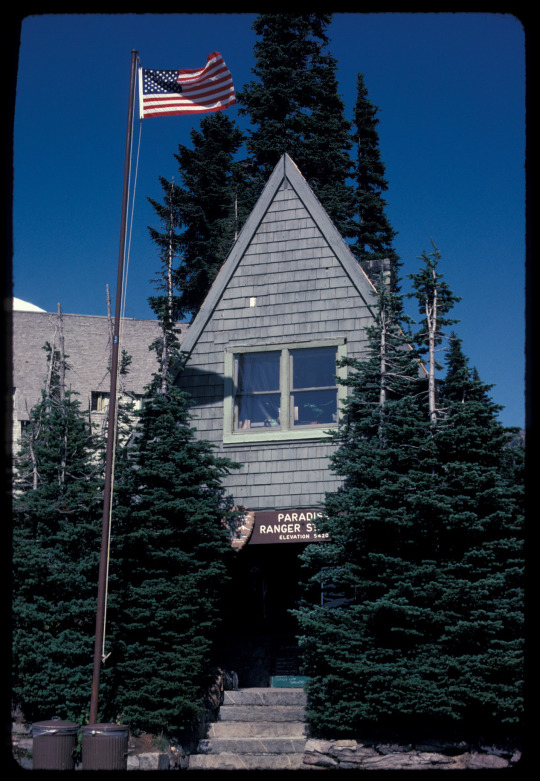
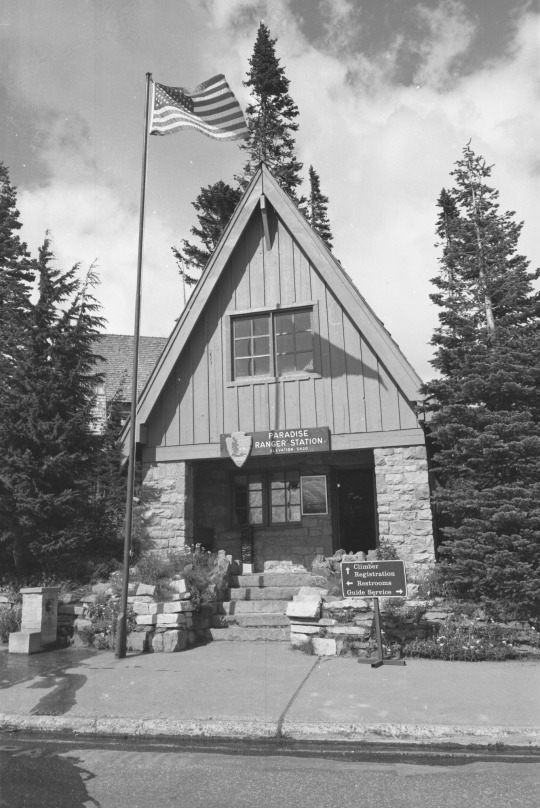
NPS Photo of the ranger station in 1984 (left). Mount Rainier National Park Archives Photo courtesy Val Lou photo of the Paradise Ranger Station in the 1990s (right).
The first floor of the ranger station was originally used as an information and checking station, with living quarters in the second story. The information center has since moved to the Climbing Guide House behind the ranger station, but the Paradise Ranger Station still serves as office space for rangers today. Have you noticed this building when visiting Paradise?
#Historic Mount Rainier#mount rainier national park#Paradise Ranger Station#Paradise#National Historic Landmark District#historic building#ranger station#NPS Rustic#architecture
86 notes
·
View notes
Text
I went to visit my soon to be office. Using the metro with a wheelchair SUCKS but at least I don't have to change trains. Everyone was super accommodating (A couple people did push me/touch my chair without permission though) but overall it went well. Those historic buildings are surprisingly accessible. Rolling on the cobblestones suck though.
I'll miss doing fieldwork everyday but in the long term this is better for my health. I'll still volunteer to do macroinvertebrate surveys but I won't have to push myself to work outside if I'm not feeling well.
I'm hoping to focus on at-home bug rearing once I get my own place. So I'll still be a disabled naturalist, just less frequently outside.
#wrenfea.exe#i need to get a smartdrive my arms hurt#my fibro makes it so no matter how strong my muscles get they still get sore and fatigued from even a little exertion
44 notes
·
View notes
Text

Are there guided tours or educational programs offered at Brooklyn Bridge Park?
Brooklyn Bridge Park stands as an iconic and expansive waterfront destination that offers breathtaking views of the Manhattan skyline, the Brooklyn Bridge, and the Statue of Liberty. Beyond its natural beauty, the park has become a hub for recreational activities, cultural events, and educational programs. In this article, we delve into the various educational initiatives and guided tours available at Brooklyn Bridge Park.
Educational Programs:
Brooklyn Bridge Park is not only a place for leisure but also an educational resource for visitors of all ages. The park hosts a range of educational programs designed to connect people with the environment and promote an understanding of the park's ecosystems. These programs cover topics such as ecology, sustainability, and urban wildlife.
Environmental Education Programs:
Led by knowledgeable educators, these programs focus on the park's diverse ecosystems, including its marshes, meadows, and gardens.
Participants may engage in hands-on activities, wildlife observation, and interactive workshops to deepen their understanding of urban ecology.
Sustainability Initiatives:
Brooklyn Bridge Park is committed to sustainability, and educational programs often highlight the park's green practices.
Topics may include recycling efforts, composting, and the use of renewable energy sources within the park.
Guided Tours:
Exploring Brooklyn Bridge Park on your own can be rewarding, but guided tours offer a more immersive and informative experience. Whether you're a local or a visitor, these tours provide insights into the park's history, design, and natural features.
Architectural Tours:
Led by knowledgeable guides, these tours delve into the park's architectural features, providing a historical perspective on the transformation of the waterfront.
Participants learn about the park's design elements, the role of landscape architecture, and the integration of public art.
Ecological Tours:
Guided ecological tours focus on the park's unique ecosystems, offering participants the chance to explore the diverse flora and fauna.
Knowledgeable naturalists lead these tours, providing insights into the park's biodiversity and the importance of urban green spaces.
Historical and Cultural Tours:
These tours take participants on a journey through the history of Brooklyn Bridge Park, exploring its evolution from industrial waterfront to a vibrant public space.
Cultural aspects, such as public art installations and events, are also highlighted during these tours.
Conclusion:
Brooklyn Bridge Park is not only a picturesque destination but also a rich source of educational opportunities and guided tours. Whether you're interested in the park's ecological diversity, architectural design, or historical significance, there are programs and tours tailored to cater to a variety of interests. So, the next time you visit Brooklyn Bridge Park, consider immersing yourself in one of these educational experiences to gain a deeper appreciation for this urban oasis.
#new york city#new-york#new york#newyork#nyc#ny#manhattan#urban#city#usa#United States#buildings#travel#journey#outdoors#street#architecture#visit-new-york.tumblr.com#Bridge#Brooklyn Bridge#Brooklyn Bridge Park
180 notes
·
View notes
Text


The Naturalist's Guidebook, Part 4
The Keysmash Code
TYPE: Tool
TIME: Real Posting Hours
RARITY: Occasional
DESCRIPTION:
The Keysmash Code is an impenetrable sequence of characters which Tumblr users encode their emotions into. There is a logic to it, but only to the one who presses the keys. Learning to understand the diverse Keysmash Codes of one’s neighbors on Tumblr is a key stage (pun intended) of the life-cycle of a new arrival. A great deal of information can be passed through the code: not only emotion but device of choice, language of origin, and even age. It is one of the native modes of expression, in common usage far back into the history of Tumblr.
FIELD NOTES:
The Code can be used to transmit valuable and secret data to trusted friends and associates without risking interference.
Encoding techniques go in and out of fashion, like clothing or music, so it is possible to use relics which contain Keysmashes in order to date artifacts to a particular time or place.
The Keysmash Code is possibly related to a phenomenon known as “crytyping,” but this theory needs more research before it is proven.
6K notes
·
View notes
Text

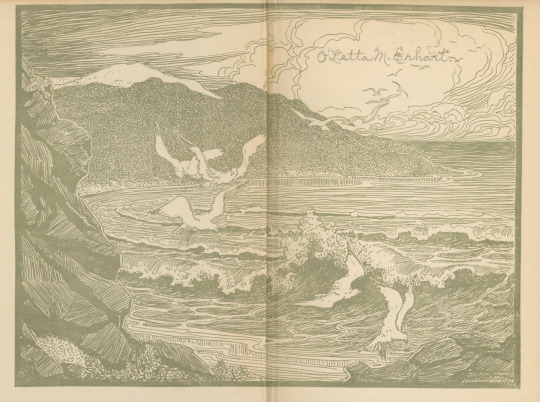
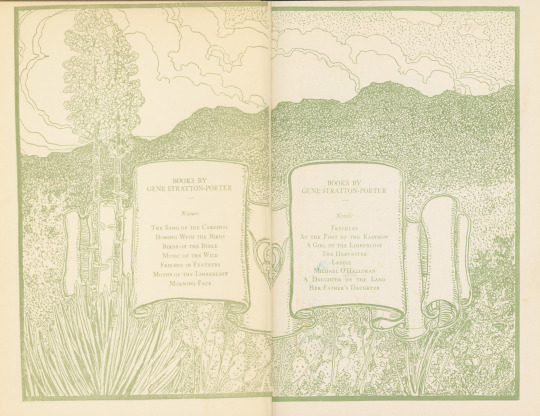

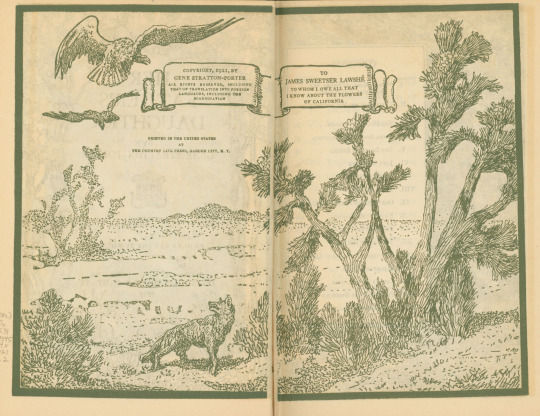





Publishers' Binding Thursday
Today we visit a volume that looked familiar to me right when I first saw it. This is Her Father's Daughter by Hoosier writer, photographer, and naturalist Gene Stratton-Porter (1863-1924), published in 1921 by Doubleday, Page & Company. The book's front matter is highly illustrated, in a way very similar to that of another Gene Stratton-Porter book in our collection that I have posted about before in this series—The Keeper of the Bees. That book was decorated by American artist and mystery novel author Lee Thayer (1874-1973), who I suspect may have also done the decoration in this volume, though I haven't been able to confirm that suspicion.
The cover is simple but pretty, with the title in a lovely serif font with a particularly swoopy R and yellow flowers. The frontispiece is by English painter and illustrator Dudley Gloyne Summers (1892-1975). The decorative endpapers and other front matter depict various nature scenes.
View more Publishers' Binding Thursday posts.
-- Alice, Special Collections Department Manager
#Publishers' Binding Thursday#Her Father's Daughter#Gene Stratton-Porter#Lee Thayer#Doubleday Page & Company#Dudley Gloyne Summers#decorated endpapers#frontispieces
75 notes
·
View notes
Text
Bestiaryposting Results -- Gligglae
Sorry this is later than usual; traveling for the holidays makes it difficult to keep up with this sort of thing. The smart move would have been to write it up a couple days ahead of time, then on Monday just update it with anything new that had been posted since, but see, what happened was that I did not do that. Instead, I tried to type this up Monday evening in between various family obligations, realized I didn't have time to do it properly, and just shoved it in my drafts. Then all of Tuesday was taken up with the long drive back home from where my family lives, and now you're getting it on Wednesday.
(Also, don't worry, I followed all CDC guidelines appropriate for someone who had recently had covid, and wouldn't have traveled for the holidays at all if I hadn't been without a fever for 48 hours prior to departing. Plus I drove instead of flying, didn't visit anyone but immediate family, and had a mask the whole time, so even if I am still contagious somehow, exposure was pretty minimal.)
Anyway, the entry that our artists are working from is here:
And, of course, all previous material on this matter can be found at https://maniculum.tumblr.com/bestiaryposting.
I think a larger number of people than usual identified the animal in question right off the proverbial bat, because this one has some pretty blatant tells, but as always I appreciate everyone trying to put it out of their minds.
So, anyway, in rough chronological order:
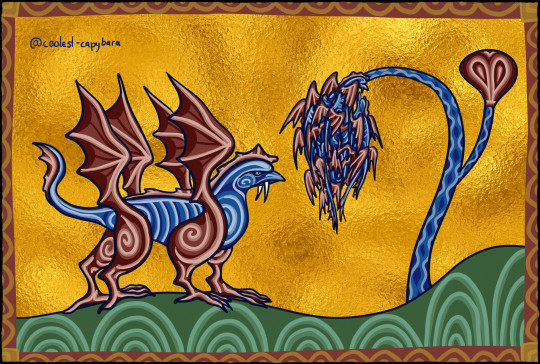
@coolest-capybara (link to post here) (thank you for providing your own alt text, I really appreciate it) brings us her usual impeccably medieval-stylized rendition -- the swirls and curves in this one give it a really interesting vibe, I think. We can see the Gligglae in full-body profile on the left there, and a group of them doing their cluster behavior on the right. The, like, griffin/cockatrice/vampire look is pretty great, also. I enjoy the overall design, which you can find some discussion of in the linked post. Gold foil also a nice touch.
Coolest-capybara also notes that the entry is very interested in the ways in which the creature is "almost, but not quite, entirely unlike a bird," and I can explain why that is. It is because this entry is in the Bird section of the bestiary, so officially this is a bird -- I mean, it flies, what else can it be -- but it's sufficiently un-bird-like that it really sticks out to the authors, so they need to explain the ways in which it's Doing Bird Wrong. Everything else in this section does X, so we need to point out that this one does Y, kind of thing.
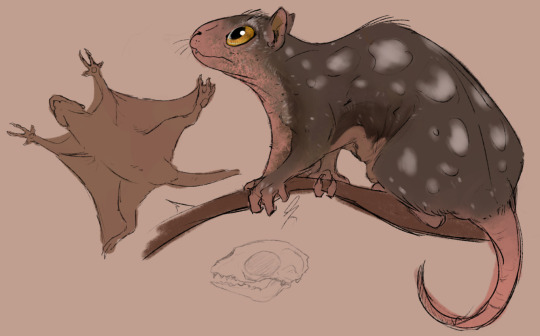
@silverhart-makes-art (link to post here) has drawn an absolutely adorable little Gligglae. (Adorable if you have my sense of aesthetics, that is -- I suspect if you're among the portion of the population that finds aye-ayes more creepy-looking than cute, that might apply here as well.) There's an explanation of design decisions in the linked post, including a number of references to real animals that provided inspiration. I like the decision to play up the "lowly" and "mean" part of the description by making it small and kind of scruffy. And the general concept of blending "gliding rodent" with "nocturnal primate" to make an arboreal mammal with elements of both really worked out well here, in my opinion.
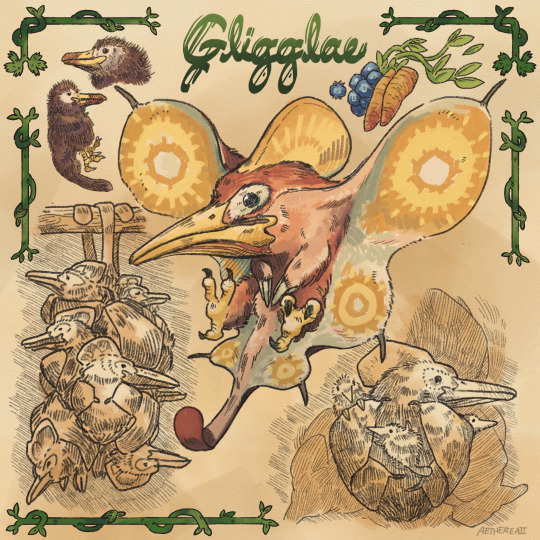
@aethereaii (link to post here) has done this beautiful piece in a style that kind of gives "19th-century naturalist" vibes. (Actually, it makes me think of James Gurney, but I suspect that association says more about my childhood reading habits than anything else.) This is a great design in my opinion, and you can find some brief discussion on design decisions as well as an earlier version of the Gligglae in the linked post. The earlier design is also very good, but I agree with Aethereaii that this one is a step up, particularly with the Anomalocaris-inspired faux-wings. I also really like the inclusion of the juvenile Gligglae (Gligglings?) clinging to their parent's back in the corner there.
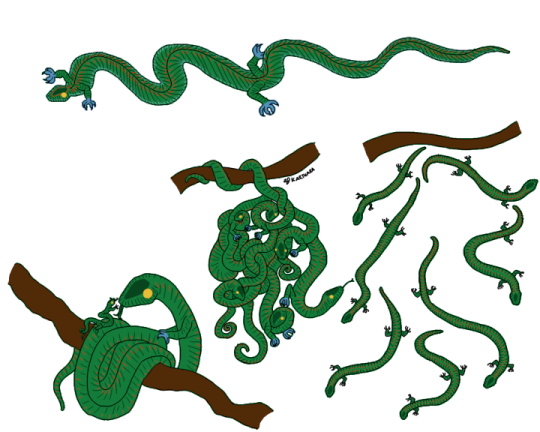
@karthara (link to post here) decided to go in a reptilian direction with this one, which (a) works well and (b) caused me to spend a chunk of time reading about flying snakes on Wikipedia just now. So in this version, the "rowing motion with its skin" is a description of the Gligglae flaring its ribs and undulating through the air -- which I genuinely think really makes sense. The entry seems to legitimately disagree with itself about whether this critter has wings (or, taking it entirely literally, it has wings but flies through a completely separate method that specifically does not involve said wings, which I think we're justified in deciding is Wrong), so I think going with such a non-wing-like flight method works here. Also like the concept of making these very cuddly (and apparently loving, according to our bestiary author) creatures into a type of animal that usually isn't seen that way. The linked post also contains some brief notes on design decisions.
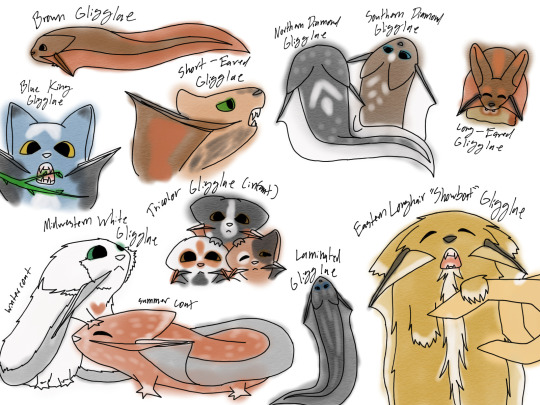
@strixcattus (link to post here) has, as per usual, provided a really excellent modern-naturalistic description of the creature they've designed in the linked post, and you should definitely go check it out right now. I'll wait.
... back? Okay good. I particularly like their interpretation of the "grape-cluster" behavior as a social group that's specifically not a kin group; and also the fact that said group is officially referred to as a "cuddle". The choice to make it a whole genus and show us several different wild and domesticated species, also very good, love it. As with several of these drawings, Strixcattus's Gligglae (Gligglaes?) are extremely cute -- which, really, does also fit the description provided in the entry. They're like tadpoles crossed with sugar gliders.

@cheapsweets (link to post here) credits Ken Sugimori's Pokemon illustrations as a stylistic inspiration, which I suppose explains why the Gligglae cluster seems to be hanging from a Sudowoodo. The linked post also draws certain parallels between medieval bestiaries and the Pokedex, which I think is actually pretty insightful. There's also a breakdown of their design decisions there, go read it. I think this is a pretty good rendering of something that is like a flying squirrel but distinctly not a flying squirrel, and I like the shaggy look of the fur.
Also, thank you for providing your own alt text.
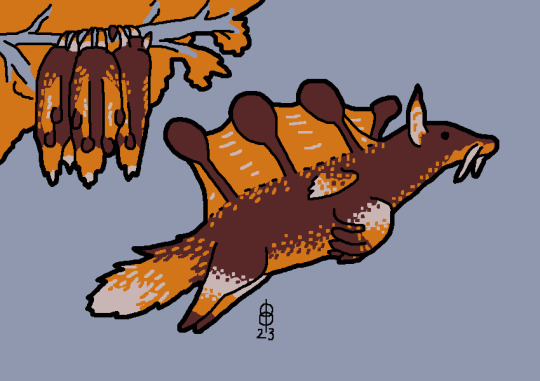
@pomrania (link to post here) is, I think, the only person to take the bestiary author at their word that this animal has wings but flies through some other, non-wing-related method. You can see the tiny useless wings at the shoulder there. I really think that's fascinating as a concept: what evolutionary pressures would produce an animal that (a) has wings and (b) flies but (c) those two things are unrelated? Although this many appendages on a fur-bearing creature puts us firmly in the "alien biology" territory, so maybe it's silly to expect it to make sense by the standards of terrestrial biology. Regardless, I like it, and I think the decision to run with the "rowing" description by giving it those oar-shaped appendages is a good & creative one. The post linked above contains a fair bit of information on design decisions and the drawing process here -- there are sketches and everything.
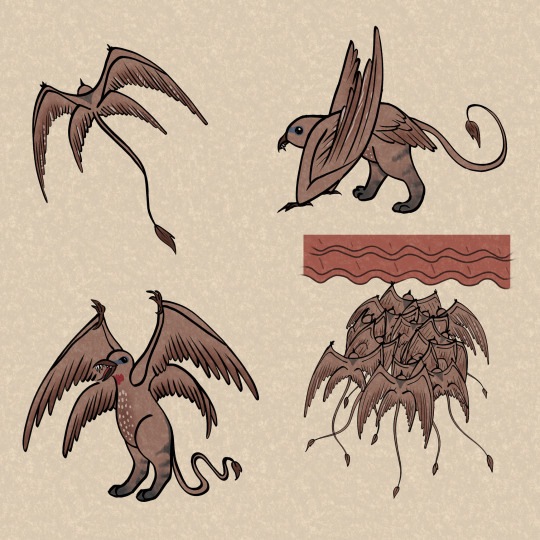
@vindikat (link to post here) has interpreted this in a way I find really charming. The art is of course excellent, very well drawn, and I appreciate the effort that went into doing these different poses. However, I really like it from a worldbuilding perspective: this gives me the impression of a small species of griffin that's adapted to urban living, more pigeon/cat than eagle/lion. (Come to think, both pigeons and cats are examples of feral populations finding a successful niche, rather than wild ones that adapt to a city, so maybe we can speculate that these guys are also descended from domestic ancestors.) Also the Gligglae under the eaves there remind me of pictures of chimney swifts that have made the rounds on Tumblr.
The design is also generally very appealing; I think the extra wings and the long tail really work here. The linked post includes an explanation of the design decisions that I think is worth taking a look at.

@moustawott (link to post here) has given us another very cuddly version of the Gligglae. I particularly like the wing design here, how it's kind of a mammalian version of a pterosaur -- Moustawott indicates that they were specifically trying not to draw the animal that they're sure this is, and I think the pterosaur-squirrel design here is a great way to make something that could fill kind of the same niche while being an unmistakably distinct creature. The little round head and eye markings remind me of a chipmunk, also, which is cute.
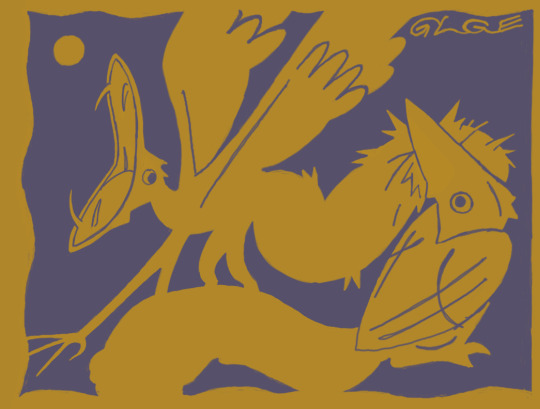
@rautavaara (link to post here) continues to do interesting stylistic stuff with their contributions. I like how the limited color palette here makes this look kind of like a single-block woodcut or similar relief printing. Like, you could plausibly see this as a design someone's carved into a wood block, then printed on mustard-yellow paper with purple ink. (I'm actually not 100% sure that's not what it is; I would just be surprised if someone actually went the extra mile of breaking out the engraving tools for my little bestiaryposting thing.) Very dynamic scene, also, and a charming creature design; love the huge mouths with pointy little fangs.
All right, these are all the ones that come up on the search; if I missed yours, let me know please.
(I have to apologize here for another delay that's absolutely my fault -- I would have had this out a few hours ago, but I got derailed by impulsively deciding to check out that Hbomberguy plagiarism video everyone's talking out, and... yeah.)
Anyway, as a number of this week's artists indicated, this one was really easy to guess, so the reveal seems a little pointless, but we have a format, so:
Obviously, this was the sheep.
What? Look, you can't make assumptions with these things. Some of these medieval bestiary entries are really counterintuitive. Medieval Europeans believed there was a species of small, highly-social, flying nocturnal sheep native to Ethiopia.
Really, it's in Pliny the Elder.
...
Yes, fine, I'm just lying to you for fun. It's the animal you all think it is, there are no flying sheep to my knowledge. Here's the Aberdeen Bestiary illustration.

Yep, it's the bat. Oddly human face on that one, and generally I don't think this was drawn from life, but it's definitely a bat.
I do kind of find the way it's described in this entry kind of interesting, though. The confusion about whether bats count as having wings (even after having been placed in the "bird" category) is kind of odd, and the "rowing" description is not one I would have ever thought of. I very much like the declaration that the way bats huddle together is "an act of love of a sort which is difficult to find among men"; it's a sweet way to talk about a creature with a generally negative reputation, which contrasts interestingly with the fact that the author also thinks of them as "lowly" and "mean". You kind of get the idea of a creature that's a bit wretched but in a sympathetic way. "Scrungly", one might say.
98 notes
·
View notes
Text

The Embrace (1937) by Léonard Sarluis (1874-1949), Netherlands born French painter.
Born in the Hague in October of 1874, French painter Salomon-Léon Sarluis, known as Léonard Sarluis, studied at the École des Beaux-Arts before moving to Paris in 1884 where he became a well known figure on its boulevards. He was a student of the French Symbolist painter Armand Point and of the French novelist Élémir Bourges, who was strongly linked with the Decadent and Symbolist movements in literature. Sarluis was also associated with the openly gay poet Jean Lorrain, who is remembered for his contributions to the satirical weekly Le Courrier Français and his Decadent novels and short stories.
Léonard Sarluis traveled widely throughout Italy, visiting Naples, and Russia. Upon his return to Paris, he exhibited at the Salon de la Rose Croix and the Salon des Artistes Français, and at a number of other Parisian galleries. With designer Armand Point, Sarluis created the poster for the fifth exhibition at the Salon des Artistes Français, depicting Perseus holding the severed head of novelist Émile Zola, who was rejected by the Symbolists for his Naturalist social commentary.
Working under the influence of Point, Léonard Sarluis combined a technique inspired by the Old Masters with a style that was sensual and very modern. He liked to work on a grand scale, and his monumental “Nero”, exhibited at the Galerie Georges Petit in Paris, was greatly admired by muralist painter Puvis de Chavannes. In 1919 Sarluis had a solo exhibition at the Galerie Bernheim, one of the oldest galleries in Pairs and a leader in avant-garde art.
In 1923, Sarluis produced illustrations based on novelist Gaston Pavloski’s 1912 mystical “Voyage to the Land of the Fourth Dimension”. For a number of years, Sarluis worked on a series of three hundred-sixty paintings entitled “A Mystical Interpretation of the Bible”, which were shown at the Grafton Galleries in London in 1926.
Léonard Sarluis’s inspiration was emblematic of a turn of the century that combined nostalgia for an imagined past, decadent themes and sometimes cloudy mysticism. A provocative character and dandy, and a friend of Oscar Wilde, Salomon-Léon Sarluis died in 1949 in Paris.
56 notes
·
View notes
Text

Plan of HMS Beagle - Middle section fore and aft, upper deck, 1832
In: A Naturalist's Voyage Round the World, Journal of Researches into the Natural History and Geology of the countries visited during the voyage round the world of H.M.S. Beagle under the command of Captain Fitz Roy, R.N., By Charles Darwin, M.A., F.R.S., with illustrations by R. T. Pritchett, 1832
#naval history#naval artifacts#deckplans#hms beagle#exploration /survey vessel#1832#history#age of sail
84 notes
·
View notes
Text
Some Beekeeper's Picnic characters!
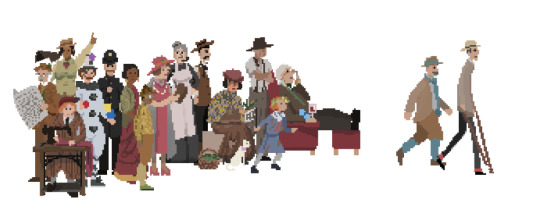
Tilda is a budding naturalist with a special passion for frogs, newts, jellyfish and all things which dwell in the deep. She struggles to make friends her own age, but loves to visit Holmes and hear all about his bees.
After losing her husband in the War, Mrs Kumar started a successful haberdashery business. She is fiercely protective of her son Sanjay, and her elderflower cordial is considered to be absolutely divine.
Master of the custard pie and the pratfall, Ruffles the Clown can send just about anyone into fits of giggles with his antics. Who he is underneath the grease paint and hijinks remains is anybody's guess.
Mrs Fanny Whitlock is the fastidious head of the Village fete Planning Committee. No soggy-bottomed cakes are allowed on her watch! She has a secret love for a series of crime novels which star a Lichtensteinian detective called Kasper Hassler.
79 notes
·
View notes
